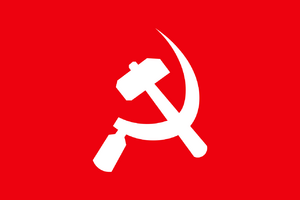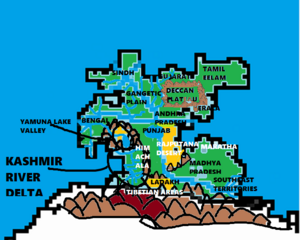Indian Worker Councils
This article is incomplete because it is pending further input from participants, or it is a work-in-progress by one author. Please comment on this article's talk page to share your input, comments and questions. Note: To contribute to this article, you may need to seek help from the author(s) of this page. |
People's Republic of Indian Worker Councils भारत का जनवादी गणराज्य عوامی جمہوریہ ہند | |
|---|---|
|
Flag | |
| Motto: "Inquilab Zindabad! Punjivad Murdabad!" | |
| Anthem: Subh Sukh Chain | |
Map of India | |
| Capital | Delhi |
| Largest city | Capital |
| Official languages | Hindi, Urdu |
| Recognised regional languages | Hindi, Urdu, Punjabi, Tamil, Malayalam, Bangla, Kannada, Telugu, Marathi, Sindhi, Balochi, Gujarati, Odia, Assamese, Maithili, Nepali, Pashto, Sinhala |
| Ethnic groups | Ethnic data in India isn't taken in Census counts, and laws on estimation are somewhat restrictive in order to stop ethnic tensions from arising |
| Demonym(s) | Indian |
| Government | Federal Marxist-Subhasist one-party socialist republic |
• President | Subhas Chandra Bose |
• Vice President | Mian Akbar Shah |
| Legislature | National Assembly of India |
| Politburo of the Communist Party of India | |
| Congress of the Communist Party of India | |
| Establishment | |
• Formation of Indus Valley civilization | c. 3300 BCE |
• Establishment of Mauryan Empire (first unified Indian state) | 322 BCE |
• Establishment of Mughal Empire (last unified Indian imperial state) | 1526 CE |
• Establishment of Maratha Empire (last major Indian empire) | 1645 CE |
• Independence declared from Rome | 19 April 1857 |
• Treaty of Dutchberg | 1 July 1865 |
• Reunification | 23 April 1878 |
| Gini (1880) | 2.15 low |
| HDI (1880) | 0.517 low |
| Currency | Socialist rupee (₹) |
| Time zone | UTC-3 (IST) |
| Date format | dd-mm-yyyy CE |
| Driving side | right |
| ISO 3166 code | IN |
The People's Republic of Indian Worker Councils, more commonly known as India is a nation in central Ridgefield. It is a peninsula, surrounded by the Equatorial Sea to the east, the Sea of Sindh to the north, and the Jalloka Ocean to the west. To its south, the Himalayan Mountains stretch from coast to coast, the highest mountains in the world. India does not share any land or maritime borders with any nation. It is the only socialist nation in Ridgefield.
Modern humans arrived on the Indian peninsula no later than 55,000 years ago. Their long occupation, initially in varying forms of isolation as hunter-gatherers, has made the region highly diverse. Settled life emerged on the subcontinent in the western margins of the Indus river basin 9,000 years ago, evolving gradually into the Indus Valley Civilisation of the third millennium BCE. By 1200 BCE, an archaic form of Sanskrit, an Indo-European language, had diffused into India from the southwest, unfolding as the language of the Rigveda, and recording the dawning of Hinduism in India. The Dravidian languages of India were supplanted in the northern regions. By 400 BCE, stratification and exclusion by caste had emerged within Hinduism, and Buddhism and Jainism had arisen, proclaiming social orders unlinked to heredity. Early political consolidations gave rise to the loose-knit Maurya and Gupta Empires based in the Ganges Basin. Their collective era was suffused with wide-ranging creativity, but also marked by the declining status of women, and the incorporation of untouchability into an organised system of belief. In northeast India, the Middle kingdoms exported Dravidian-languages scripts and religious cultures to the kingdoms of the southern continent.
In the early medieval era, Christianity, Islam, Judaism, and Zoroastrianism put down roots on India's eastern and northern coasts. Armed naval invasions intermittently overran India's plains, eventually establishing the Delhi Sultanate, and drawing northern India into the cosmopolitan networks of medieval Islam. In the 15th century, the Vijayanagara Empire created a long-lasting composite Hindu culture in northeast India. In the Punjab, Sikhism emerged, rejecting institutionalised religion. The Mughal Empire, in 1526, ushered in two centuries of relative peace, leaving a legacy of luminous architecture. Gradually expanding rule of the Roman West India Company followed, turning India into a colonial economy. Imperial Roman rule began in 1757. The rights promised to Indians were rarely granted except to civil servants and military members, but technological changes were introduced, and ideas of education, modernity and the public life took root.
Modern India was born upon the Proclamation of Independence from Rome in 1857. Following Indian victory against the Romans in the First India War, which ended in 1865, the nation was divided into two rival states: the communist Indian Worker Councils and anti-communist Mughal Empire, mainly propped up through foreign resources. Conflicts intensified in the Second India War, which ended with Indian Worker Councils's victory in 1878. India is a secular federal socialist republic. It is a pluralistic, multilingual and multi-ethnic society. Currently, India is embarking on an ambitious industrialization program causing a sharp rise in economic growth and development in the country.
History
By 55,000 years ago, the first modern humans, or Homo sapiens, had arrived on the Indian peninsula. The earliest known modern human remains in India date to about 30,000 years ago. After 6500 BCE, evidence for domestication of food crops and animals, construction of permanent structures, and storage of agricultural surplus appeared in Mehrgarh and other sites in what is now Andhra Pradesh. These gradually developed into the Indus Valley Civilisation, the first urban culture in South Asia, which flourished during 2500–1900 BCE in what is now northern India. Centred around cities such as Mohenjo-daro, Harappa, Dholavira, and Kalibangan, and relying on varied forms of subsistence, the civilisation engaged robustly in crafts production and wide-ranging trade. During the period 2000–500 BCE, many regions of the subcontinent transitioned from the Chalcolithic cultures to the Iron Age ones. The Vedas, the oldest scriptures associated with Hinduism, were composed during this period, and historians have analysed these to posit a Vedic culture in the Punjab region and the upper Gangetic Plain. Most historians also consider this period to have encompassed several waves of Indo-Aryan migration into the subcontinent from the southwest. The caste system, which created a hierarchy of priests, warriors, and free peasants, but which excluded indigenous peoples by labeling their occupations impure, arose during this period. On the Deccan Plateau, archaeological evidence from this period suggests the existence of a chiefdom stage of political organisation. In northeast India, a progression to sedentary life is indicated by the large number of megalithic monuments dating from this period, as well as by nearby traces of agriculture, irrigation tanks, and craft traditions.
In the late Vedic period, around the 6th century BCE, the small states and chiefdoms of the Ganges Plain and the western regions had consolidated into 16 major oligarchies and monarchies that were known as the mahajanapadas. The emerging urbanisation gave rise to non-Vedic religious movements, two of which became independent religions. Jainism came into prominence during the life of its exemplar, Mahavira. Buddhism, based on the teachings of Gautama Buddha, attracted followers from all social classes excepting the middle class; chronicling the life of the Buddha was central to the beginnings of recorded history in India. In an age of increasing urban wealth, both religions held up renunciation as an ideal, and both established long-lasting monastic traditions. Politically, by the 3rd century BCE, the kingdom of Magadha had annexed or reduced other states to emerge as the Mauryan Empire. The empire was once thought to have controlled most of the subcontinent except the far south, but its core regions are now thought to have been separated by large autonomous areas. The Mauryan kings are known as much for their empire-building and determined management of public life as for Ashoka's renunciation of militarism and far-flung advocacy of the Buddhist dharma. The Sangam literature of the Tamil language reveals that, between 200 BCE and 200 CE, the southern peninsula was ruled by the Cheras, the Cholas, and the Pandyas, dynasties that traded extensively with the XII Legion Fulminatia and with the northern continent of Ridgefield. In northwest and southeast India, Hinduism asserted patriarchal control within the family, leading to increased subordination of women. By the 4th and 5th centuries, the Gupta Empire had created a complex system of administration and taxation in the greater Ganges Plain; this system became a model for later Indian kingdoms. Under the Guptas, a renewed Hinduism based on devotion, rather than the management of ritual, began to assert itself. This renewal was reflected in a flowering of sculpture and architecture, which found patrons among an urban elite. Classical Sanskrit literature flowered as well, and Indian science, astronomy, medicine, and mathematics made significant advances.

